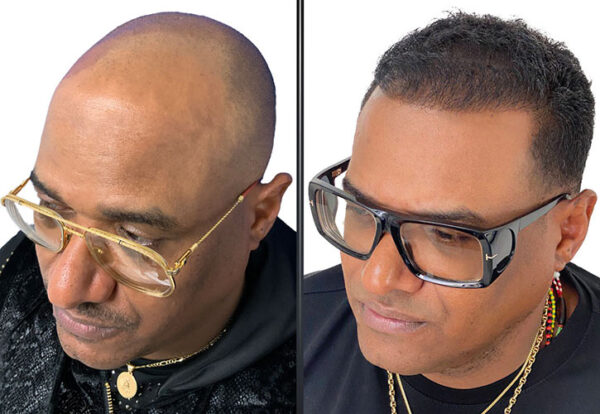
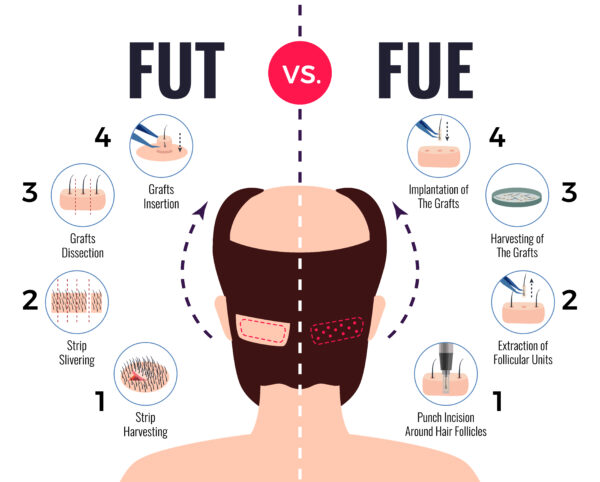
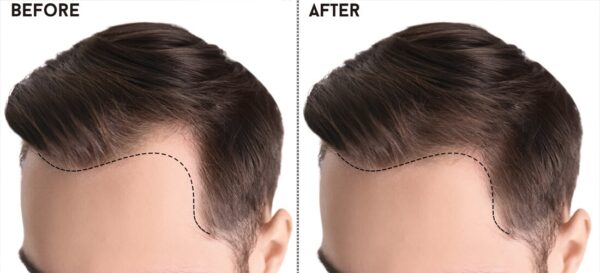
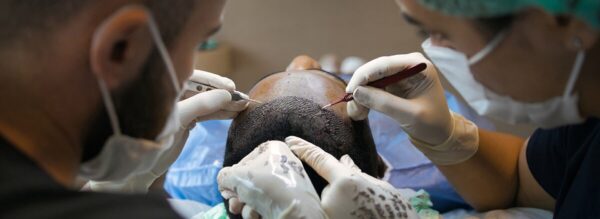

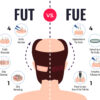
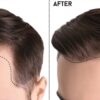
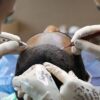

Free
Embark on a transformative journey with our exceptional range of medical treatments. As a leading medical tour operator, we offer a comprehensive selection of world-class treatments and procedures to address your unique healthcare needs. From advanced surgeries to cutting-edge therapies, our team of experienced professionals is dedicated to providing top-notch care and ensuring your comfort and satisfaction. Discover a new level of healthcare excellence with our tailored treatment options. Book now to start your journey towards a healthier and happier you.
Follicular Unit Transplantation (FUT) is a hair restoration technique that involves transplanting hair in naturally occurring groups of 1 to 4 hairs, known as follicular units. FUT is also referred to as the strip procedure because it involves removing a strip of skin from the back or sides of the scalp, which is then dissected into individual grafts. These grafts, consisting of follicular units, are then transplanted into the bald or thinning areas of the scalp.
The advantages of FUT include the ability to transplant thousands of grafts in a single session, maximizing the cosmetic impact of the procedure. FUT is considered an advancement over older hair transplantation methods that used larger grafts, which often resulted in a pluggy and unnatural appearance. When properly performed, FUT results in a natural-looking hair growth pattern that is undetectable as a hair transplant.
The FUT procedure typically involves the following steps:
Preparation: Before the procedure, the patient’s scalp is cleaned, and the donor and recipient areas are marked.
Donor area harvesting: A strip of skin, usually from the back or sides of the scalp, is surgically removed. The size of the strip depends on the number of grafts needed. The incision is then closed with sutures or staples.
Graft dissection: The strip of skin is carefully dissected under a microscope to separate it into individual follicular units. Each unit contains one to four hairs, along with sebaceous glands, nerves, small muscles, and occasional fine vellus hairs.
Recipient site creation: Tiny incisions are made in the recipient area, where the grafts will be transplanted. The surgeon strategically places the incisions to ensure a natural-looking hairline and overall distribution.
Graft transplantation: The dissected follicular units are then transplanted into the recipient sites using specialized instruments. The surgeon ensures proper angulation, direction, and density to achieve a natural appearance.
Postoperative care: After the procedure, the patient may experience some discomfort, swelling, and scabbing in both the donor and recipient areas. Pain medication and antibiotics may be prescribed to manage pain and prevent infection. Follow-up appointments will be scheduled to monitor progress and provide guidance on postoperative care.
Follicular Unit Transplantation (FUT) is suitable for individuals experiencing male pattern baldness or other types of hair loss. It is particularly effective for those looking to restore a receding hairline or fill in balding areas. FUT works best for individuals who have a sufficient donor area, which is typically the back or sides of the scalp, where hair follicles are not influenced by the hormone dihydrotestosterone (DHT), responsible for most hair loss.
During the FUT procedure, a surgeon cuts a strip of skin from the donor area, usually from the back of the head. This strip is then dissected into individual follicular units, which are small groups of hair follicles. These follicular units are then transplanted into the balding or thinning areas of the scalp.
Follicular Unit Transplantation (FUT) may not be suitable for everyone. Here are some factors that may make FUT less appropriate:
Limited donor hair: FUT requires a sufficient amount of donor hair, typically from the back or sides of the scalp, to transplant into the bald or thinning areas. If a person has limited donor hair or has already undergone multiple hair transplant procedures, FUT may not be feasible.
Desire to wear short hairstyles: FUT leaves a linear scar at the donor site, which can be covered by surrounding hair. However, if a person prefers to wear very short hairstyles that expose the donor area, FUT may not be the best option. Follicular Unit Extraction (FUE) or other hair restoration methods that do not leave a linear scar may be more suitable.
Tight scalp or scalp laxity issues: FUT requires the surgeon to remove a strip of skin from the scalp. If a person has a tight scalp or scalp laxity issues, it may affect the ability to safely remove the strip and close the incision properly.
Preference for minimal scarring: While FUT can provide excellent results, it does leave a linear scar at the donor site. If a person is concerned about visible scarring or prefers a minimally invasive approach, they may consider other hair transplant methods like FUE or robotic hair transplantation.
Medical conditions or contraindications: Certain medical conditions or medications may affect the suitability of FUT. It is important to consult with a qualified surgeon who can evaluate your specific circumstances and determine if FUT is appropriate for you.
Follicular Unit Transplantation (FUT) offers several advantages for individuals considering hair restoration. Here are some key benefits of FUT:
Maximizes graft yield: FUT allows for the transplantation of a large number of grafts in a single session. The strip of skin harvested during FUT contains a higher number of follicular units compared to other methods, maximizing the number of grafts available for transplantation. This can result in a more significant cosmetic impact and improved hair density.
Natural-looking results: FUT is known for producing natural-looking results. The use of follicular units, which consist of 1 to 4 hairs, mimics the way hair grows naturally. The surgeon strategically places the grafts to create a hairline and overall distribution that blends seamlessly with the existing hair.
Suitable for extensive hair loss: FUT is particularly suitable for individuals with extensive hair loss or larger areas of baldness. The ability to transplant a higher number of grafts in a single session makes FUT an effective option for covering larger areas of the scalp.
Cost-effective: FUT can be a cost-effective option compared to other hair transplant methods. Since a larger number of grafts can be transplanted in a single session, fewer sessions may be required to achieve the desired results, reducing overall costs.
Long-term viability: The transplanted hair follicles in FUT are typically resistant to the hormone dihydrotestosterone (DHT), which is responsible for most hair loss. This means that the transplanted hair is less likely to fall out over time, providing long-term viability and a lasting solution for hair restoration.
Follicular Unit Transplantation (FUT) is generally a safe and effective procedure for hair restoration. However, like any surgical procedure, there are potential complications and risks associated with FUT. Here are some of the possible complications:
Scarring: FUT involves the removal of a strip of skin from the donor area, which results in a linear scar. The visibility of the scar can vary depending on factors such as the individual’s healing ability, the skill of the surgeon in closing the incision, and the length of the hair surrounding the scar. Although efforts are made to minimize scarring, it is important to consider the potential for a visible scar when opting for FUT.
Numbness and Sensation Changes: Some individuals may experience temporary or permanent numbness or changes in sensation in the donor or recipient areas. This can occur due to nerve damage during the procedure. In most cases, sensation returns to normal over time, but it is important to discuss this potential risk with your surgeon.
Infection: As with any surgical procedure, there is a risk of infection. Following proper postoperative care instructions and taking prescribed antibiotics can help minimize this risk.
Bleeding: Bleeding is a potential complication during and after the FUT procedure. Surgeons take precautions to control bleeding during the surgery, and patients are advised to avoid activities that may increase blood flow to the scalp immediately after the procedure.
Delayed Healing: Some individuals may experience delayed healing of the incision site or the transplanted grafts. Factors such as poor wound care, underlying medical conditions, or individual healing responses can contribute to delayed healing.
Unnatural-looking Results: While FUT is known for producing natural-looking results, there is a possibility of the transplanted hair appearing unnatural if not properly placed or if the hairline design is not well-executed. Choosing an experienced and skilled surgeon can help minimize this risk.
Preoperative care for Follicular Unit Transplantation (FUT) is an essential part of ensuring a successful procedure and optimal results. Here are some key aspects of preoperative care:
Consultation and Evaluation: The first step in the preoperative process is to schedule a consultation with a qualified hair transplant surgeon. During this consultation, the surgeon will evaluate your hair loss pattern, assess the donor area, discuss your goals and expectations, and determine if you are a suitable candidate for FUT.
Medical History and Medication Review: It is important to provide your surgeon with a comprehensive medical history, including any underlying medical conditions, allergies, or medications you are currently taking. Certain medications, such as blood thinners, may need to be adjusted or temporarily discontinued before the procedure.
Smoking and Alcohol: If you smoke or consume alcohol, your surgeon may advise you to refrain from these activities for a certain period before the surgery. Smoking and excessive alcohol consumption can impair healing and increase the risk of complications.
Avoid Blood-Thinning Substances: Your surgeon may instruct you to avoid blood-thinning substances, such as aspirin, nonsteroidal anti-inflammatory drugs (NSAIDs), and herbal supplements, as they can increase the risk of bleeding during and after the procedure.
Hair Care: It is generally recommended to avoid cutting or shaving your hair too short before the procedure. Having some length to the hair in the donor area can help conceal the linear scar that may result from FUT.
Preoperative Instructions: Your surgeon will provide you with specific preoperative instructions to follow. These may include guidelines on when to stop eating and drinking before the surgery, what to wear on the day of the procedure, and any specific hair care instructions.
Arrange Transportation: Since FUT is performed under local anesthesia, you may not require general anesthesia. However, it is still advisable to arrange for someone to drive you home after the procedure, as you may experience some postoperative discomfort or drowsiness.
Postoperative care is crucial for ensuring proper healing and optimal results after Follicular Unit Transplantation (FUT). Here are some key aspects of postoperative care:
Follow Surgeon’s Instructions: It is important to carefully follow the postoperative instructions provided by your surgeon. These instructions may include guidelines on medication usage, wound care, and activities to avoid during the recovery period.
Medication and Wound Care: Your surgeon may prescribe antibiotics to prevent infection and pain medication to manage any discomfort. It is important to take these medications as directed. Additionally, you may be instructed to keep the surgical area clean and apply any recommended topical ointments or dressings.
Avoid Physical Activity: It is generally advised to avoid strenuous physical activities, heavy lifting, and exercise for a certain period after the procedure. This helps prevent excessive sweating, which can interfere with the healing process.
Protect the Transplanted Area: It is important to protect the transplanted area from direct sunlight, extreme temperatures, and trauma. Wearing a hat or using sunscreen with a high SPF can help shield the scalp from harmful UV rays.
Gentle Hair Washing: Your surgeon will provide specific instructions on when and how to wash your hair after the procedure. Typically, a gentle shampoo is recommended, and you should avoid rubbing or scratching the transplanted area.
Avoid Smoking and Alcohol: Smoking and excessive alcohol consumption can impair the healing process. It is advisable to avoid smoking and limit alcohol intake during the recovery period.
Follow-up Appointments: Your surgeon will schedule follow-up appointments to monitor your progress and assess the healing of the transplanted hair. It is important to attend these appointments and discuss any concerns or questions you may have.
Only logged in customers who have purchased this product may leave a review.
Follicular Unit Extraction (FUE) is a hair transplant procedure that involves the extraction and transplantation of individual hair follicles from a donor area to areas of the scalp experiencing hair loss or thinning. Here is an explanation of the FUE procedure:
Principle of FUE: FUE is based on the principle that the area of attachment of the arrector muscle to the follicular unit is the tightest zone. By making this attachment area loose and separating it from the surrounding dermis, the inferior segment of the follicular unit can be extracted easily. Small micropunches, typically ranging from 0.6 to 0.8 mm in size, are used to extract the follicular units. The resulting scars from these tiny punches are usually too small to be recognized.
Extraction Process: During the FUE procedure, the surgeon uses specialized instruments, such as a circular scalpel, punch, or motorized drill, to extract individual hair follicles from the donor area. The donor area is typically the back or sides of the scalp, where the hair is genetically programmed to continue growing for life. The extraction process involves making small incisions around the follicular units and carefully extracting them from the scalp.
Transplantation Process: Once the follicular units are extracted, they are meticulously transplanted into the recipient area of the scalp. The recipient area is the balding or thinning area where hair restoration is desired. The surgeon creates tiny incisions in the recipient area and places the extracted follicular units into these incisions. The transplanted follicles will then establish a blood supply and start growing hair in the recipient area.
Advantages of FUE: FUE offers several advantages over other hair transplant methods. It is considered minimally invasive, as it does not involve the removal of a strip of skin like Follicular Unit Transplantation (FUT). FUE also typically results in less postoperative discomfort, faster healing time, and decreased chances of visible scarring. The individual extraction of follicular units allows for precise placement, resulting in natural-looking results.
Follicular Unit Extraction (FUE) is suitable for individuals experiencing hair loss or thinning who meet certain criteria. Here are some factors that determine suitability for FUE:
Sufficient Donor Hair: FUE requires a sufficient amount of healthy donor hair to be extracted and transplanted to the recipient area. The donor area is typically the back or sides of the scalp, where the hair is genetically programmed to continue growing for life. The density and quality of the donor hair play a role in determining candidacy for FUE.
Pattern Baldness: FUE is commonly used to treat pattern baldness, also known as androgenetic alopecia. It is suitable for individuals with male or female pattern baldness who have areas of baldness or hair thinning that can be addressed through transplantation.
Hair Loss Stability: It is important for individuals considering FUE to have stable hair loss. This means that their hair loss has stabilized, and they are not experiencing rapid or progressive hair loss. Stable hair loss ensures that the transplanted hair will not be affected by ongoing hair loss in the future.
Realistic Expectations: Candidates for FUE should have realistic expectations about the outcome of the procedure. While FUE can provide significant hair restoration, it may not achieve a full head of hair or restore hair to its original density. A thorough consultation with a qualified surgeon can help set realistic expectations.
General Health: Overall general health is an important consideration for any surgical procedure, including FUE. Candidates should be in good health and free from any medical conditions that may interfere with the healing process.
Follicular Unit Extraction (FUE) may not be suitable for everyone. Here are some factors that may make an individual unsuitable for FUE:
Limited Donor Hair: FUE requires a sufficient amount of healthy donor hair to be extracted and transplanted. If an individual has limited donor hair, such as in cases of extensive hair loss or a depleted donor area, they may not have enough hair available for transplantation.
Unstable Hair Loss: FUE is typically recommended for individuals with stable hair loss. If an individual’s hair loss is still progressing rapidly, it may not be the right time for FUE. It is important to stabilize hair loss before considering transplantation to ensure long-term results.
Poor Donor Site Quality: The quality of the donor site, typically the back or sides of the scalp, is crucial for successful FUE. If the donor area has poor hair density, weak hair follicles, or scarring from previous surgeries, it may not be suitable for FUE.
Reversible Hair Loss: FUE is not recommended for individuals experiencing hair loss due to reversible causes, such as medication side effects, stress, or medical treatments. It is important to address the underlying cause of hair loss before considering surgical interventions.
Unrealistic Expectations: It is essential for individuals considering FUE to have realistic expectations about the outcome of the procedure. FUE can provide significant hair restoration, but it may not achieve a full head of hair or restore hair to its original density. A thorough consultation with a qualified surgeon can help set realistic expectations.
General Health Concerns: Individuals with certain health conditions or medical concerns may not be suitable candidates for FUE. It is important to discuss any underlying health conditions with a qualified surgeon to determine if FUE is appropriate.
Follicular Unit Extraction (FUE) offers several advantages compared to other hair transplant methods. Here are some of the advantages of FUE:
Minimally Invasive: FUE is a minimally invasive procedure that does not involve the removal of a strip of skin from the donor area, as in Follicular Unit Transplantation (FUT). Instead, individual hair follicles are extracted using small punches, typically ranging from 0.6 to 0.8 mm in size. This results in smaller incisions and less postoperative discomfort.
No Visible Linear Scar: One of the significant advantages of FUE is that it leaves no visible linear scar in the donor area. The extraction of individual follicles allows for scattered tiny scars that are usually too small to be recognized. This makes FUE a preferred option for individuals who prefer shorter hairstyles or who want to keep their hair short in the donor area.
Natural-Looking Results: FUE allows for precise placement of individual follicles, resulting in natural-looking hair restoration. The ability to extract and transplant individual follicles gives the surgeon more control over the placement and direction of the transplanted hair, leading to aesthetically pleasing results.
Faster Healing and Recovery: The smaller incisions and minimal tissue trauma associated with FUE generally result in faster healing and recovery compared to other hair transplant methods. The reduced healing time allows individuals to return to their regular activities sooner.
Versatility: FUE can be used to address various degrees of hair loss, from minor thinning to more extensive baldness. It is suitable for both men and women and can be performed on different areas of the scalp, including the hairline, crown, and temples.
Less Postoperative Discomfort: Due to the minimally invasive nature of FUE, individuals typically experience less postoperative discomfort compared to other hair transplant methods. The smaller incisions and reduced tissue trauma contribute to a more comfortable recovery period.
Follicular Unit Extraction (FUE) is generally considered a safe and effective hair transplant procedure. However, like any surgical procedure, there are potential complications and risks associated with FUE. Here are some of the complications that can occur:
Scarring: While FUE leaves minimal scarring compared to other methods, there can still be tiny white scars where the follicles were extracted. These scars are usually small and not easily noticeable. In rare cases, individuals may develop hypertrophic scars or keloids, which are raised and more visible.
Infection: Although rare, there is a risk of infection following FUE. Proper sterile techniques during the procedure and postoperative care can help minimize this risk. Signs of infection may include increased pain, redness, swelling, or discharge from the surgical site.
Tissue Death (Necrosis): In extremely rare cases, tissue death can occur at the site where the surgery was performed. This can happen due to compromised blood supply to the area. It is important to follow postoperative care instructions and seek immediate medical attention if you notice any signs of tissue death, such as blackening or severe pain in the surgical area.
Temporary Side Effects: Some individuals may experience temporary side effects after FUE, which typically resolve within a few days. These side effects may include swelling, bruising, and sensitivity in the donor and recipient areas. These are usually mild and subside on their own.
Poor Hair Growth: In some cases, the transplanted hair may not grow as expected. Factors such as poor graft survival, improper placement, or underlying medical conditions can contribute to suboptimal hair growth. It is important to choose a skilled and experienced surgeon to minimize the risk of poor hair growth.
The preoperative care for Follicular Unit Extraction (FUE) typically involves certain considerations and preparations to ensure a successful procedure. While the specific preoperative care instructions may vary depending on the surgeon and individual circumstances, here are some general aspects to be aware of:
Consultation and Evaluation: Before undergoing FUE, it is important to schedule a consultation with a qualified hair transplant surgeon. During this consultation, the surgeon will evaluate your hair loss pattern, assess the donor area, discuss your expectations, and determine if you are a suitable candidate for FUE.
Medical Evaluation: A comprehensive medical evaluation may be conducted to assess your overall health and identify any underlying medical conditions that could affect the procedure or recovery. It is important to disclose your complete medical history, including any medications, allergies, or previous surgeries.
Medication Adjustments: Your surgeon may provide specific instructions regarding medications to avoid or adjust before the procedure. This may include avoiding blood-thinning medications or supplements that can increase the risk of bleeding during the surgery.
Smoking and Alcohol: It is generally recommended to refrain from smoking and consuming alcohol for a certain period before the procedure, as they can interfere with the healing process and increase the risk of complications.
Hair Care: Your surgeon may provide instructions on how to prepare your hair for the procedure. This may involve washing your hair with a mild shampoo before the surgery and avoiding the use of hair products, such as gels or sprays, on the day of the procedure.
Fasting: Depending on the anesthesia used during the procedure, you may be instructed to fast for a certain period before the surgery. This is typically done to minimize the risk of complications related to anesthesia.
Arrangements for Transportation: Since FUE is performed under local anesthesia, you may not require transportation after the procedure. However, if sedation or general anesthesia is used, it is important to arrange for someone to drive you home after the surgery.
The postoperative care following Follicular Unit Extraction (FUE) is crucial for proper healing and optimal results. While the specific instructions may vary depending on the surgeon and individual circumstances, here are some general aspects of postoperative care for FUE:
Medication and Dressings: Your surgeon may prescribe medications, such as antibiotics or pain relievers, to prevent infection and manage any discomfort. Follow the prescribed medication schedule and instructions for dressings or bandages applied to the donor and recipient areas.
Avoid Touching or Scratching: It is important to avoid touching or scratching the transplanted area to prevent dislodging the grafts. Your surgeon may provide specific instructions on how to care for the transplanted area and when it is safe to gently wash or touch the area.
Sleeping Position: Sleeping with your head elevated on pillows for the first few nights after the procedure can help reduce swelling and promote healing. Your surgeon may provide specific instructions on the ideal sleeping position.
Avoid Strenuous Activities: It is generally recommended to avoid strenuous activities, heavy lifting, and exercise that can increase blood pressure and strain the surgical area for at least a week or as advised by your surgeon. Gradually resume normal activities as instructed by your surgeon.
Hair Washing: Your surgeon will provide specific instructions on when and how to wash your hair after the procedure. Typically, gentle hair washing can be resumed within a few days to a week after the surgery. Use a mild shampoo and follow the instructions provided by your surgeon.
Avoid Sun Exposure: Protect the transplanted area from direct sun exposure for a few weeks after the procedure. Wear a hat or use sunscreen with a high SPF to prevent sunburn and minimize the risk of hyperpigmentation.
Follow-up Appointments: Attend all scheduled follow-up appointments with your surgeon to monitor the healing process and address any concerns or questions you may have. Your surgeon will assess the progress of the transplant and provide further guidance.
There are no reviews yet.
Only logged in customers who have purchased this product may leave a review.
Choosing the right hospital and physician are important factors to consider that significantly influence a patient’s treatment. The preferred choice for many patients is choosing private care.
Choosing the right hospital and physician are important factors to consider that significantly influence a patient’s treatment.
Reviews
There are no reviews yet.